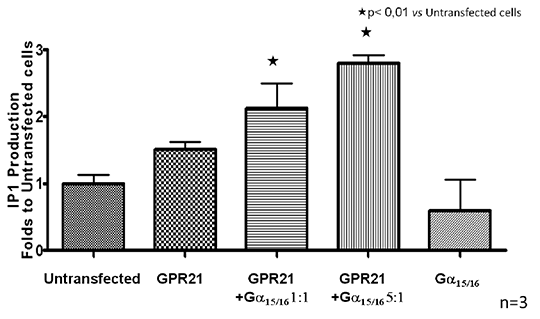The GPR21 Receptor As An Innovative Pharmacological Target For Type 2 Diabetes The prevalence of type 2 diabetes has been rising for the last few decades, and is now recognized as a worldwide, major epidemic. Despite several pharmacological strategies available, many patients are unable to achieve glycemic control, thus the therapeutic need remains. GPR21 is an orphan member of the G-protein coupled receptor (GPCR) superfamily. It has been identified recently as a diabetes-susceptibility gene, thereby suggesting its involvement in the pathogenesis of this disease. Analysis of the GPR21 knock out mouse revealed that the deletion of this receptor improves glucose tolerance, insulinemia, and systemic insulin sensitivity, indirectly, possibly by decreasing macrophage migration into adipose tissue [1,2]. The aim of this study was to evaluate the role of GPR21 as modulator of insulin signaling to better understand its involvement in insulin resistance. Human Embryonic Kidney 293 cells (HEK 293) were transiently transfected with plasmids encoding the GPR21 receptor (Origene), tagged with the c-Myc epitope. Transfection was evaluated by Western blotting, monitoring the expression of GPR21 using an anti-Myc (tag) antibody. A lipofectamine (μl):GPR21DNA(μg) ratio of 6:2 for 24 h successfully transformed the cells. GPR21 constitutive activity was evaluated by measuring Inositol 1 phosphate production (TR-FRET-based IP1 assay; Cisbio). The ability of GPR21 to affect insulin signaling was evaluated by exposing GPR21-transfected cells to insulin (100 nM, 50 min). Phosphorylation of AKT and AS160, obligatory intermediates in the insulin response, was measured by Western-blotting. Statistical analysis was performed using one-way ANOVA with Dunnett’s post-test, as applicable; a p value<0.05 was considered significant. GPR21 constitutive activity was significantly (p<0.01) increased by co-transfection with two different subtypes of Gq protein family, the promiscuous Gα15/16 (see Figure) and Gq, but not with Gα14. Expression of GPR21 substantially reduced insulin-induced phosphorylation of both AKT and AS160 (p<0.01).
In conclusion, our results indicate that GRP21 is a constitutively active receptor that acts as a negative regulator of the insulin signaling. Notably, our findings closely mirror the previously published knock out data [1,2], but indicate that the influence of GPR21 extends beyond the macrophage, suggesting a direct role for this receptor as an insulin sensitivity modulator. Thus, shutting down the constitutive activity of GPR21 could represent an interesting pharmacological strategy in type 2 diabetes. (1) Osborn O. et al. (2012). J Clin Invest 52: 2444-2453. (2) Gardner J et al. (2012). 418:1-5. Biochem. Biophys. Res. Commun. 418:1-5.
|


